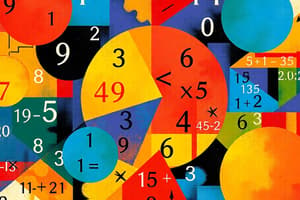Podcast
Questions and Answers
What type of numbers are crucial for representing non-integer quantities?
What type of numbers are crucial for representing non-integer quantities?
- Whole numbers
- Fractions
- Decimal numbers (correct)
- Integers
What symbol is used to represent fractions in comparisons?
What symbol is used to represent fractions in comparisons?
- >=
- >
- < (correct)
- <=
Which type of quantities do variables in algebra represent?
Which type of quantities do variables in algebra represent?
- Whole numbers
- Decimal numbers
- Fixed quantities
- Unknown quantities (correct)
How are integers represented using symbols?
How are integers represented using symbols?
What is the basic operation not mentioned for fractions in the text?
What is the basic operation not mentioned for fractions in the text?
Which method is NOT used to solve linear equations in one variable?
Which method is NOT used to solve linear equations in one variable?
What is a common method for solving quadratic equations?
What is a common method for solving quadratic equations?
In geometry, what does the Cartesian coordinate system represent points on?
In geometry, what does the Cartesian coordinate system represent points on?
What are the measures of central tendency used to describe in statistics?
What are the measures of central tendency used to describe in statistics?
Which section covers the concept of probability?
Which section covers the concept of probability?
Flashcards are hidden until you start studying
Study Notes
Class 10 Mathematics: A Crash Course
Class 10 mathematics is a pivotal point in the educational journey of students, laying a strong foundation for more complex concepts ahead. In this article, we'll dive into some of the essential topics covered in Class 10 mathematics and demystify the subject to help you navigate your educational journey with confidence.
Number Systems
Whole Numbers
You'll learn the basics of whole numbers, including operations like addition, subtraction, multiplication, and division. You'll also encounter decimal numbers, which are crucial for representing non-integer quantities.
Fractions
This section will introduce you to fractions and their operations, such as addition, subtraction, multiplication, and division. You'll learn about mixed numbers and improper fractions, and you'll learn how to compare fractions using the less-than (<) and greater-than (>) symbols.
Integers
In this section, you'll learn about integers and their properties, including their representation using the integer symbol (±), and their operations, such as addition, subtraction, multiplication, and division.
Algebra
Variables and Expressions
You'll learn to work with variables, representing quantities that can be changed or unknown. You'll learn about variables' properties and the different kinds of expressions you can create using them.
Linear Equations in One Variable
Once you're familiar with variables, you'll learn how to solve linear equations in one variable, which involve expressions of the form ax + b = c. You'll learn different methods of solving linear equations, such as the substitution method, elimination method, and graphical method.
Quadratic Equations
In this section, you'll learn about quadratic equations, which involve expressions of the form ax² + bx + c = 0. You'll learn about the different methods of solving quadratic equations, such as factoring, completing the square, and the quadratic formula.
Geometry
Circles
You'll learn about circles, including their properties, such as diameter, radius, chord, arc, sector, segment, and tangent. You'll learn how to find the area and circumference of a circle using its diameter, radius, or length of an arc.
Constructions
You'll learn how to construct geometric shapes using a ruler and a compass, such as a circle, perpendicular bisector of a line segment, and a line of reflection.
Three-dimensional Geometry
You'll learn about three-dimensional geometry, including the properties, formulas, and measures of various shapes and objects, such as cubes, cuboids, cylinders, and cones.
Coordinate Geometry
Plane Coordinate Geometry
You'll learn about the Cartesian coordinate system, representing points on a plane using ordered pairs of numbers. You'll learn how to find the distance between two points, the midpoint of a line segment, and the slope of a line.
Three-dimensional Coordinate Geometry
This section will introduce you to the three-dimensional Cartesian coordinate system, representing points in three-dimensional space using ordered triples of numbers. You'll learn how to find the distance between two points, the midpoint of a line segment, and the direction ratios of a line.
Statistics and Probability
Data Representation
You'll learn how to represent data using various graphical and numerical methods, such as bar graphs, histograms, pie charts, and frequency distributions.
Measures of Central Tendency
You'll learn about the mean, median, and mode, which are measures of central tendency used to describe the average or typical value of a dataset.
Measures of Dispersion
You'll learn about the range, quartiles, and standard deviation, which are measures of dispersion used to describe the spread or variation of a dataset.
Probability
In this section, you'll learn about probability, including the concepts of experimental probability, theoretical probability, and conditional probability. You'll learn how to use probability to make predictions and decisions.
Remember, this is just an overview of the topics covered in Class 10 mathematics. As you navigate through the subject, you'll discover that each topic is broad and interconnected with other areas of mathematics. Enjoy learning and new challenges as you delve deeper into the fascinating world of mathematics!
Studying That Suits You
Use AI to generate personalized quizzes and flashcards to suit your learning preferences.




